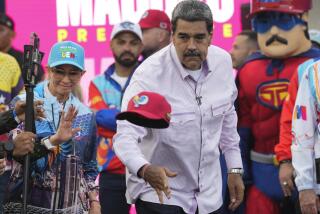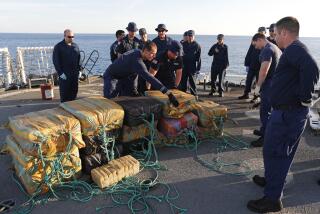Drug agents target West Africa routes
- Share via
BOGOTA, COLOMBIA — Alarmed by the rise in Latin American drug traffic in West Africa, nations including Colombia, Brazil and the United States are establishing or increasing their police presence in that unstable region.
Racked by internal strife that has left them poor, crime-ridden and institutionally weak, several West African nations in recent years have become key transit hubs for Colombian, Peruvian and Bolivian cocaine headed to Europe.
In an interview last week, Colombian National Police commander Gen. Oscar Naranjo said he would soon station 10 anti-narcotics police in nine West African countries, with a headquarters in Sierra Leone.
“We want to establish a common front with these countries, to help identify the Colombian traffickers who come and go,” Naranjo said during a police graduation ceremony in El Espinal, Colombia.
In Washington, Drug Enforcement Administration spokesman Garrison Courtney said Wednesday that his agency was also beefing up its presence in West Africa, although he did not specify how many agents would be added or where.
“The drug traffic is now going both ways. Cocaine is moving through Africa and on to Europe, while precursor chemicals from China and India for making methamphetamines are now transiting through on the way to Central America and Mexico,” Courtney said.
Three years ago, before the tide of Andean cocaine began to hit West African shores, the DEA had only one agent in the region, in Lagos, Nigeria. But the agency and other U.S. law enforcement organizations are now focusing on the area, partly because of fears that drug sales could be used to finance terrorism.
Brazil, which has become a major channel for Andean cocaine shipped to Europe, is also sending about half a dozen narcotics agents to West Africa, said one foreign narcotics agent who spoke anonymously because he was not authorized to speak for publication.
As much as half of all Andean cocaine is consumed in Spain, Britain and elsewhere in Europe, experts say. Although U.S. cocaine consumption has leveled off this decade, users in Europe have more than doubled in the last four years, according to a United Nations report.
Traffickers are rushing to take advantage of the boom in Europe, where the wholesale price of a kilogram (2.2 pounds) of pure cocaine fetches more than $45,000. That’s twice the wholesale price in Miami, officials have said.
To access that market, traffickers now send a quarter or more of Europe-bound cocaine through West African way stations they view as hospitable.
In Guinea-Bissau, one of the world’s 10 poorest nations, there is no prison and the few dozen policemen are notoriously malleable.
The country has a two-ship navy to patrol its 220-mile coastline.
Colombian traffickers, who are thought to control 60% to 80% of Andean cocaine, have made the biggest splash in the region, with several taking up residence in Guinea-Bissau and establishing “front” businesses, narcotics officials here say.
Two suspected members of the rebel group Revolutionary Armed Forces of Colombia were arrested -- and mysteriously released -- in Guinea-Bissau in 2007 while on a drug trafficking mission, the foreign narcotics official said.
Until last summer, when a tougher law was passed, Guinea-Bissau’s maximum penalty for drug traffickers, even if they were caught with several tons of cocaine, was a $1,000 fine. Justice Minister Carmelita Pires held a news conference at the time to denounce several death threats she had received.
Law enforcement is coming around to the challenge. Cocaine seizures in West Africa or offshore totaled 14.6 tons in 2006, up from less than a ton in 2001, according to the U.N. Office on Drugs and Crime.
In 2007, 4 tons of cocaine was seized in Mauritania and Senegal alone.
Last year’s major busts included half a ton of cocaine aboard an airplane that crash-landed at Sierra Leone’s international airport, and 2.5 tons found on a Liberian freighter off Sierra Leone’s capital, Monrovia.
Estimates of annual Colombian cocaine production range from about 600 tons, according to the U.N. agency, to 750 tons, according to the White House Office of National Drug Control Policy.
A third of all Colombian cocaine now moves through Venezuela and then on to U.S. and European markets, according to U.S. officials.
In September, the State Department classified Venezuela as “uncooperative” in the war on drugs, citing alleged corruption among high-level police and national guard officers.
The corruption has made cocaine trafficking to Europe via West Africa easier, the State Department report said. Venezuelan officials deny the corruption charges.
--
More to Read
Sign up for Essential California
The most important California stories and recommendations in your inbox every morning.
You may occasionally receive promotional content from the Los Angeles Times.










